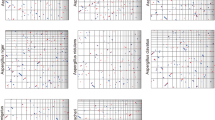Abstract
InNeurospora crassa, the expression of unlinked structural genes which encode nitrogen catabolic enzymes is subject to genetic and metabolic regulation. The negative-actingnmr regulatory gene appears to play a role in nitrogen catabolite repression. Using theN. crassa nmr gene as a probe, homologous sequences were identified in a variety of other filamentous fungi. The polymerase chain reaction was used to isolate thenmr-like gene from the exotic Mauriceville strain ofN. crassa and from the two related species,N. intermedia andN. sitophila. Sequence comparisons were carried out with a 1.7-kb DNA segment which includes the entire coding region ofnmr plus 5′ and 3′ noncoding sequences. The size of thenmr coding region was identical in all threeNeurospora species. Approximately 30 nucleotide base substitutions were found in the coding region of thenmr gene of each of the sister species when compared to the standardN. crassa sequence. However, most of the base changes occurred in third codon positions and were silent. The NMR proteins ofN. sitophila and ofN. intermedia display only three and four amino acid substitutions, respectively, from theN. crassa protein. Two regions of high variability, which include deletions and insertions of bases, were found in the 5′ and 3′ noncoding regions of the gene.
Similar content being viewed by others
References
Birnboim, H. C., and Doly, J. (1979). A rapid alkaline extraction procedure for screening recombinant plasmid DNA.Nucleic Acids Res 71513.
Davis, R. H., and de Serres, F. (1970). Genetic and microbial research techniques forNeurospora crassa.Methods Enzymol. 17A79.
Dunn-Coleman, N. S., Tomsett, A. B., and Garrett, R. H. (1981). The regulation of nitrate assimilation inNeurospora crassa: Biochemical analysis of thenmr-1 mutants.Mol. Gen. Genet. 182234.
Fitch, W. M., and Margoliash, E. (1967). Construction of phylogenetic trees.Science 155279.
Fu, Y. H., and Marzluf, G. A. (1990a). nit-2, the major nitrogen regulatory gene ofNeurospora crassa, encodes a protein with a putative zinc finger DNA-binding domain.Mol. Cell. Biol. 101056.
Fu, Y. H., and Marzluf, G. A. (1990b). nit-2, the major positive-acting nitrogen regulatory gene ofNeurospora crassa, encodes a sequence-specific DNA-binding protein.Proc. Natl. Acad. Sci. USA 875331.
Fu, Y. H., Young, J. L., and Marzluf, G. A. (1988). Molecular cloning and characterization of a negative-acting nitrogen regulatory gene ofNeurospora crassa.Mol. Gen. Genet. 21474.
Jarai, G., and Marzluf, G. A. (1990). Analysis of conventional and in vitro generated mutants ofnmr, the negatively acting nitrogen regulatory gene ofNeurospora crassa.Mol. Gen. Genet. 222233.
Kudla, B., Caddick, M. X., Langdon, T., Martinez-Rossi, N. M., Bennett, C. F., Sibley, S., Davies, R. W., and Arst, H. N., Jr. (1990). The regulatory geneareA mediating nitrogen metabolite repression inAspergillus nidulans. Mutations affecting specificity of gene activation alter a loop residue of a putative zinc finger.EMBO J. 91355.
Maniatis, R., Fritsch, E. F., and Sambrook, J. (1982).Molecular Cloning, A Laboratory Manual Cold Spring Harbor Laboratory, Cold Spring Harbor, N.Y.
Marzluf, G. A. (1981). Regulation of nitrogen metabolism and gene expression in fungi.Microbiol. Rev. 45437.
Metzenberg, R. L., and Baisch, T. J. (1981). An easy method for preparing Neurospora DNA.Neurospora Newslett 2820.
Metzenberg, R. L., Stevens, J. N., Selker, E. U., and Morzycka-Wroblewska, E. (1984). A method for finding the genetic map position of cloned DNA fragments.Neurospora Newslett. 3135.
Perkins, D. D., Turner, B. C., and Barry, E. G. (1976). Strains ofNeurospora collected from nature.Evolution 30281.
Premakumar, R., Sorger, G. J., and Gooden, D. (1980). Physiological characterization of aNeurospora crassa mutant with impaired regulation of nitrate reductase.J. Bacteriol. 144542.
Sanger, F., Nicklen, S., and Coulson, A. R. (1977). DNA sequencing with chain-terminating inhibitors.Proc. Natl. Acad. Sci. USA 745463.
Sorger, G. J., Brown, D., Farzannejad, M., Guerra, A., Knight, S., and Sharda, R. (1989). Isolation of a gene that down-regulates nitrate assimilation and influences another regulatory gene in the same system.Mol. Cell. Biol. 94113.
Taylor, J. W., and Natvig, D. O. (1989). Mitochondrial DNA and evolution of heterothallic and pseudohomothallicNeurospora species.Mycol. Res. 93257.
Young, J. L., Jarai, G., Fu, Y. H., and Marzluf, G. A. (1990). Nucleotide sequence and analysis of NMR, a negative-acting regulatory gene in the nitrogen circuit ofNeurospora crassa.Mol. Gen. Genet. 222120.
Author information
Authors and Affiliations
Additional information
This research was supported by Public Health Service Grant GM-23367 from the National Institutes of Health.
Rights and permissions
About this article
Cite this article
Young, J.L., Marzluf, G.A. Molecular comparison of the negative-acting nitrogen control gene,nmr, inNeurospora crassa and otherNeurospora and fungal species. Biochem Genet 29, 447–459 (1991). https://doi.org/10.1007/BF00554045
Received:
Revised:
Issue Date:
DOI: https://doi.org/10.1007/BF00554045




